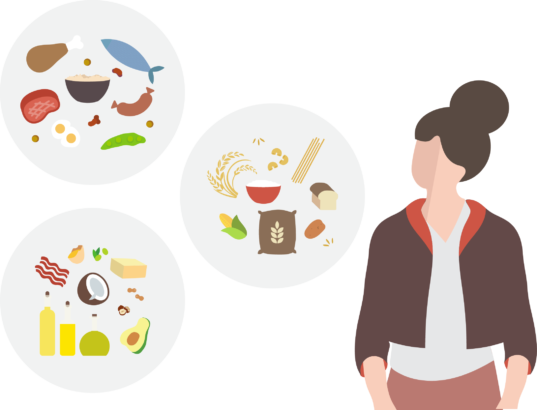HOW TO START WITH FLEXIBLE DIETING
EVEN IF YOU CAN’T STICK TO A DIET
Let me ask you something… How would you like to be able to get toned and still enjoy the food you love?
Well… I’ve got good news for you.
That’s no longer a distant dream. It’s actually something you can accomplish in days, not years!
Say hello to flexible dieting.
And before the term dieting scares you, let me tell you another thing…
In fact, I will let Jaclyn–one of my #MacrosByPao girls–tell you something about macros and flexible dieting…

“Before, I was eating healthy, but with many restrictions which was causing my cravings to go through the roof. Since starting macros and flexible dieting, I can indulge and enjoy, while not worrying about it as long as I make sure it does not take away from my day of macros.”
There you go… plain and simple. Flexible dieting is here to stay, and in today’s post, I will cover everything you need to know to kick start your macros journey the right way.
And now that you’re fully on board, let’s talk about this as if it were a Q&A between you and me…
Ready? Let’s dive right in.

Don’t have enough time to read the whole guide now?
No worries. Let me send you a copy that includes two (2) special bonuses not found in this post:
WHAT WE’RE GOING
TO COVER…
WHAT IS
FLEXIBLE DIETING?
Flexible dieting is an eating method based on fueling your body the right way.
But it’s more typically known as counting macros.
No matter how you call it, flexible dieting will allow you to see food in a different way… a better way. You will have the right tools to give your body exactly what it needs to perform at its best.

HOW DO I KNOW
WHAT MY BODY NEEDS?
When looking for an eating method, you should strive for one that you can maintain and enjoy while taking anxiety out of the equation.
Flexible dieting is–as you may have guessed–a flexible system that you can follow knowing that you’re fueling your body with all the nutrients it needs while working on your specific goals.
It’s not a cliché that nutrition is the most important part of your training… yes, your training! Because if you want to see results from all the efforts you’re putting into your workout routine, you need your diet to be on point.

Also, the way you’re nurturing your body dictates the way you feel and perform – in all aspects of your life.
That said, flexible dieting is a precise method based on science where your caloric and macronutrient intake is determined based on your statistics, goals and activity level.
WHAT IS THE DIFFERENCE BETWEEN
FLEXIBLE DIETING AND OTHER DIETS?
To me, the biggest difference is that flexible dieting helps you stay in control of your diet, training and lifestyle.
In short, flexible dieting is not actually a “diet.” You don’t start it, do it for a month, then you go back to whatever you’ve been doing before.
It’s a way of life, it’s not something you do for a short period of time.

But why? You may ask…
Let me give you a very straightforward answer.
Most of the time, we think we’re eating well, but we’re eating in wrong proportions: too many carbs, not enough protein, etc.
Another big difference is the mindset that flexible dieting allows you to build over time. I can tell you that after a few weeks into counting macros, you will understand that there is no need to restrict yourself to achieve your goals.
You will finally understand that you can have a healthy diet that allows you to have treats without feeling guilty.
But don’t get me wrong…
It doesn’t mean you can base all your diet on “unhealthy” food… not at all!!
After all, you want a body that’s good-looking on the outside AND on the inside, no?
The good news is that counting macros and flexible dieting give you the tools to plan a tasty and healthy diet without feeling deprived.

So, the point is to help you shift your mindset from having a boring and non-sustainable dieting style to having a healthy, but most importantly, balanced and enjoyable diet that is completely tailored to your goals.
There’s also another point I want to talk about and unfortunately, it’s not as happy: Eating Disorders.
And what’s even worse, researchers estimate that 15% of young women have disordered eating attitudes and behaviors.
Every day we’re exposed to so many different diet affirmations such as:
– Decrease your carbs intake if you want to lose weight
– You can only eat healthy fats
– Be careful with the sneaky sugar in bread…
In fact, there are so many crazy recommendations and I’m sure many women could identify with them… Raise your hand if you’ve heard these before 🙋🏻…
No wonder we’re all crazy, how could ANYONE keep up with the ever-changing craziness of diet advice? Let’s just simplify and give our bodies what they need without driving us insane, okay?
That’s why the main purpose of this blog post is to give you the tools and information you need to understand that a diet goes beyond the tags “healthy” and “unhealthy” food.
DOES FLEXIBLE DIETING
WORK FOR EVERYBODY?
This is a very common question and the answer is YES!
Flexible dieting works for everybody. Whether you’re a newbie or a pro whether you lift weights or do cross fit, counting macros will help you reach your goals much more quickly.
The most important thing to remember is that the macros breakdown is and will be unique for each one of you.
Your statistics, active hours, goals, lifestyle, job nature, etc. are very different from someone else’s, so don’t waste your time trying to compare your numbers and journey to somebody else’s. If you do that, you might end up confused or with the wrong info.
That said, we’ve been talking about flexible dieting, and we mentioned a key term: macronutrients…

DO YOU KNOW WHAT
MACRONUTRIENTS ARE?
Nutrients are those substances in food that the body uses to obtain energy, synthesize tissues and regulate physical functions.
There are six classes of nutrients, but only three of them provide energy. Those nutrients are protein, fat, and carbohydrates.
And guess what? They’re also called macronutrients.

WHY ARE THEY CALLED
MACRONUTRIENTS?
Because our body needs them in large amounts.
Also, I’m sure you must have heard about micronutrients.
In few words, we are talking about “the small stuff” like vitamins and minerals, and they’re needed in relatively small amounts in your diet.
Now it’s time to dive into the details about each macronutrient so that you can understand why they’re so important for your body.
PROTEIN:
MEET YOUR BEST FRIEND!
We have been taught that protein is very important for our body because it helps us grow strong.
But do you really know what protein does?
The human body has thousands of different proteins and each one of them has a specific function…
Protein and amino acids are the building blocks of your body which means they’re very important for the recovery and muscular growth processes.
So… What does all this mean to you?
It means that you need to consume enough protein to provide your body with what it needs for those processes to take place.

Oh yes! Your body will take that protein from tissues, muscles, and enzymes which means muscle loss for you, especially if you’re eating at a deficit. Not good, right?
On the other hand, if you’re eating more protein than what your body needs, this excess is converted into glucose or stored as fat. That’s why you need to have an accurate set of macros to make sure you’re giving your body the right set of nutrients.
Also, don’t forget that protein is an energy source, it yields four (4) calories per gram and it can be found in meats, dairy, legumes, grains and vegetables.
CARBOHYDRATES:
YOUR BRAIN’S MAIN FUEL
First thing first… carbs are not your enemy!
They’re a major source of energy and they can be found as starches and sugars in grains, legumes, vegetables and fruits.
There are two main types of carbs: simple carbohydrates (sugars) and complex carbohydrates (starches and fibers).

Carbohydrates are the most readily available energy source used by your body. They provide immediate energy to cells, so it’s crucial to have an adequate carbs intake to prevent the breakdown of body proteins to fulfill glucose or energy needs.
But the most important thing about carbs is that they’re your brain’s main fuel.
In fact, researches have shown that low-carbs diets affect cognitive function.
That said, even though it’s up to you to choose the carbohydrates that better suit your needs, I strongly recommend increasing vegetables, fruits and whole grains consumption to ensure a proper fiber intake.
But that doesn’t mean you’re going to base your carbs consumption on fiber-rich foods (aka greens).
Why?
Because they’re very difficult to break down for your body, which may lead you to feel bloated.
FAT:
THAT WON’T MAKE YOU FAT!
Let’s make something clear right away… fat won’t make you fat!
There is a big misconception out there about this macronutrient even though it plays a key role in several body functions such as:
And listen up ladies… fat is also necessary for hormonal balance!
So, next time you’re planning on cutting out this macronutrient from your diet, think twice!
Overall, there are three main classes of lipids or fats: triglycerides, sterols and phospholipids.

So, are all the fats good?
No… it’s not that easy!!!
As you should know, there are two groups of fats: unsaturated fats and saturated fats.
Unsaturated fats are associated with increases in good cholesterol (HDL) and decreased risk of heart disease when eaten in moderation.
It’s in this group where you’re going to find the famous omega-3 and omega-6 which are polyunsaturated fats.
This kind of fats–also called “good fats”–can be found in mackerel, tuna, salmon, trout, nuts (peanuts, walnuts, pistachios, almonds, pecans), green and leafy vegetables, avocado, and olive oil.

On the opposite side, we have the saturated and trans fatty acids. Those are known for increasing the risk of heart disease, clogging arteries and raising cholesterol levels.
You will find those bad guys in meat, fried food, poultry, partially hydrogenated oils, etc.
But…
Let me tell you something… those “bad guys” are not the problem!
The problem is our diet and how much of those fats we consume every day.
I can’t emphasize enough how important it is to be very conscious of what we eat, but restricting certain food from your diet is not the solution to your problems, striving for balance is!
THE
TAKEAWAY
OK, this was supposed to be a casual Q&A on counting macros and flexible dieting but this took me more time than intended. I mean, it’s macros! I can talk about this all day, every day.
So, to wrap things up, when it comes to flexible dieting or any kind of diet, moderation and balance are the keys to succeed.
When you know what to eat based on your statistics, body type, goals and lifestyle, everything gets easier and you start to understand how your body works and what food suits you better. This whole macro counting experience can be very eye-opening!
NOW IT'S YOUR TURN...
You’ve read about flexible dieting and its benefits, so now it’s time to take action.
The first step?
Leave a comment to let me know if you’re counting macros or if you’re planning to do it in the upcoming months.
Not ready yet? Let me know and I’ll make sure to answer all your questions below.
Love,


Download a free PDF version of this Flexible Dieting guide…
PDF version contains all of the content found in the web-based guide plus two (2) special bonuses not found in this post




